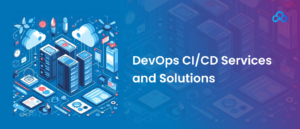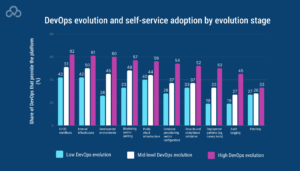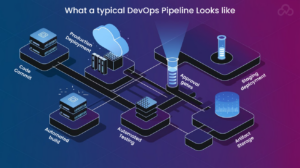DevOps CI/CD Services and Solutions: Powering Modern Software Delivery

Organizations within the digital landscape require them to develop software quickly while maintaining high reliability and reducing the number of software defects. The continuous pressure on IT departments created the conditions for DevOps to emerge as a communications platform that joins operations with development teams. CI/CD represents the core component of contemporary DevOps services because it stands as a fundamental element of modern DevOps solutions.
The CI/CD system allows teams to make development processes automated, starting from code creation to testing and moving into deployment and monitoring operations. CI/CD enables organizations to speed up product delivery while cutting human mistakes through automation and enhanced interdisciplinary teamwork to respond promptly to end-user input and deliver products faster to the market. The combination of acceleration and enhanced stability, and scalability happens through CI/CD as applications become progressively complex.
Your organization should consider revising its delivery approach when resistance persists to manual deployments, together with delayed software releases and post-launch bugs. This article explains DevOps CI/CD by analyzing important tools and pipelines while demonstrating how businesses succeed with these services in the software revolution.
What Are DevOps Services and Solutions?
The implementation of DevOps principles across the software development lifecycle (SDLC) requires all elements that DevOps services and solutions offer at their foundation. These solutions typically include:
– Software development automatically performs repetitive operations throughout the code construction and deployment process, as well as testing stages.
– The organization uses monitoring tools alongside logging solutions to discover technical issues before users encounter them.
– Infrastructure as Code (IaC) for consistent environments
– The alignment between teams becomes easier with collaboration platforms designed for this purpose.
DevOps operates beyond its toolset because it establishes a natural connection between development teams and operating personnel. The main target consists of achieving software delivery with both higher quality and increased speed and efficiency.
The Role of CI/CD in DevOps

Any progressive DevOps strategy must include basic components of Continuous Integration (CI) together with Continuous Delivery/Deployment (CD). Both processes follow specific approaches as shown in the following details:
– A shared repository receives code changes from developers through Continuous Integration (CI) processes, which occur regularly. A system of automatic testing alongside automatic builds verifies that the new code preserves functional integrity.
– CD automates the process of making ready-to-deploy code after testing has passed successfully. The process requires manual approval before the release can proceed.
– Automated production deployment occurs through Continuous Deployment because it deploys every successfully tested change directly to production without human intervention.
A combination of CI/CD tools performs automated software deployments while bug prevention happens simultaneously to enable faster iterative releases. DevOps services and solutions deliver their maximum power through this approach, which functions as the key strength of DevOps.
Why Businesses Are Investing in DevOps Services and Solutions
The practical value of DevOps implementation is no longer traceable only in theory. Enterprise and startup businesses achieve specific, measurable outcomes by adding DevOps services as a component of their software delivery operations.
Faster Time to Market
Teams can deploy new features along with updates at speed because they use automated workflows combined with integrated CI/CD pipelines, minimizing manual operations. The rapid responsiveness powered by agility allows businesses to serve market needs as well as capture customer feedback instantly, which creates a market advantage.
Improved Product Quality
Modern testing approaches, together with proactive error detection techniques along with continuous monitoring, enable developers to prevent more than half of production bugs from entering the release. The outcome of continuous integration enables software applications to maintain greater stability while creating fewer dysfunction post-release and providing improved user satisfaction right from the start.
Better Collaboration and Transparency
DevOps establishes an environment that distributes collective accountability among developers and QA engineers, and their operations counterparts. The increased workflow transparency produces more effective team process transfers and speeds up problem repair times, along with unified problem-solving methods.
Scalability
Your infrastructure can automatically expand through DevOps tools, together with best practices, which become necessary when your application requires growth. DevOps techniques allow organizations to effortlessly scale up without experiencing any service interruptions during process expansion.
Reduced Costs
DevOps automates repetitive work and decreases error possibilities, which results in a reduction of operational costs. A combination of automation investments and streamlined business processes will eventually produce considerable cost reductions, together with advanced return on investment.
Essential DevOps Tools in a CI/CD Workflow
Every DevOps pipeline requires appropriate tools to reach completion. Here are important DevOps tools that companies commonly use within their CI/CD environments:
– Version Control: Git, GitHub, GitLab, Bitbucket
– CI Servers: Jenkins, CircleCI, GitHub Actions, GitLab CI
– Build Tools: Maven, Gradle, Ant
– Containerization: Docker, Podman
– Orchestration: Kubernetes, Docker Swarm
– Configuration Management: Ansible, Puppet, Chef
– Prometheus, together with Grafana, as well as ELK Stack and Datadog, serve as systems for monitoring and logging.
– The testing tools comprise Selenium, together with JUnit and TestNG, and also include Cypress.
Your organization should select appropriate tools based on its needs for the DevOps lifecycle to work smoothly through integrated automation.
What a Typical DevOps Pipeline Looks Like

DevOps pipeline refers to programmed sequences through which development and operations personnel automate software assembly and quality testing, and delivery. Standard pipelines exhibit different arrangements, although a typical one appears like the following sequence:
Code Commit
Shared repositories function as developers’ destination to make and submit their code changes.
Automated Build
The system performs both compilation and packages the code before sending it for testing procedures.
Automated Testing
Computer systems perform automated tests for unit tests and integration tests, and multiple other testing operations.
Artifact Storage
The storage of successful artifacts occurs inside JFrog Artifactory or Nexus repositories.
Staging Deployment
During testing, the application runs in a staging environment to conduct additional checks.
Approval Gates
Both manual workforce input and automated system input trigger the advancement process.
Production Deployment
The delivery process of the application occurs in the live environment.
The structured DevOps pipeline facilitates fast and secure delivery of new code that decreases the probability of system breakdowns or functional setbacks.
Cloud-Based DevOps Services: The Next Evolution
An increasing number of organizations choose cloud-based DevOps infrastructure to gain benefits in scalability, together with flexibility. The three major cloud providers, AWS, Azure, and Google Cloud, deliver complete DevOps solutions that facilitate smooth CI/CD platforms for customers.
– AWS DevOps Services: CodePipeline, CodeBuild, CodeDeploy, CloudWatch
– Azure DevOps: Azure Pipelines, Azure Repos, Azure Boards
– Google Cloud DevOps features the trio of Cloud Build and Cloud Source Repositories, and Cloud Monitoring as key parts.
These platforms unify their DevOps services into integrated solutions that businesses of all sizes can access with pay-on-usage payment models.
Challenges in Implementing DevOps and CI/CD
Implementation of DevOps faces challenges that make the transition difficult. Here are some common challenges:
1. Organizations face resistance when adopting DevOps because transforming traditional development techniques for DevOps introduces cultural changes that some workgroups hesitate to accept.
2. DevOps teams encounter performance issues because there exists a vast number of DevOps tools, which lead to complex integration systems.
3. Security issues can arise when security measures fail to be implemented throughout every deployment stage.
4. The automation of CI/CD demands refactoring of older infrastructure and codebases to achieve proper support.
The solution to these obstacles necessitates a prepared, systematic design together with trained DevOps engineers and a continuous effort for continuous development.
Best Practices for Implementing DevOps CI/CD Services
Here are several best practices for implementing DevOps services and solutions when you plan on investing in such initiatives:
Start Small and Scale
Your organization should implement DevOps by starting with a single project, followed by introducing it to multiple teams until implementation reaches the entire organization.
Automate Everything You Can
Automated processes beginning from build coding through testing, concluding at deployment, execute delivery while diminishing faults beyond recognition.
Prioritize Security (DevSecOps)
Latent vulnerabilities will bypass production by integrating security assessment techniques at the beginning of your DevOps development cycle.
Monitor and Measure Everything
Employ logs together with metrics to monitor performance, then identify problems during their early stages.
Foster a Culture of Collaboration
The teams of developers, testers, and operations need to eliminate their divisions so they can work towards common goals.
Choosing a DevOps Partner: What to Look For
Outside expertise from DevOps services providers generates fast progress if your organization does not possess the required knowledge. Here’s what to look for:
1. The provider should demonstrate their capability to execute successful DevOps projects through their previous work.
2. Do they possess knowledge about both your existing tools along your upcoming tools?
3. Their ability to integrate DevSecOps security practices within your workflows represents the main security aspect to evaluate.
4. The solutions provider shows a customized approach to development for business objectives, matching your individual needs.
5. DevOps functions continuously because it represents an everlasting development process. The provider must offer sustained assistance to their customers.
The Future of DevOps CI/CD
Continuous technological progress in artificial intelligence and machine learning predicts a smarter and more responsive DevOps future. CI/CD pipelines will develop smarter abilities to change their operations instantly using information from system performance and user conduct, and data monitoring. Predictive analytics systems should detect upcoming deployment failures, thereby allowing teams to prevent failures through preemptive actions. Computer programs operated by AI can decrease human effort in quality assurance by finding errors during early development phases.
Edge computing alongside IoT technology gives indications of transforming the DevOps environment. Decentralized systems hosting increased applications and connected devices will require teams to use extremely automated, resilient DevOps pipelines to manage distributed network deployments. The pipelines require abilities to tackle multiple workflow complexities, together with instant updates and minimal latency and complete security, along system stability.
The organizations that dedicate resources to mastering contemporary DevOps services and solutions right now will establish their position as digital leaders of the future. Modern businesses that plan infrastructure developments based on future technology changes gain the ability to constantly innovate and confidently grow their operations.
FAQs
1. What are DevOps services and solutions?
DevOps services and solutions consist of automated, integrated approaches and technological tools that unite IT operations with software development activities. Organizations benefit through CI/CD pipelines and automation features with collaboration tools to develop software at higher speeds with better reliability.
2. How does a DevOps pipeline work?
If you have DevOps pipeline operations, you can establish an automatic progression for your code that advances from development to production. The complete process consists of initial source code management, followed by automated building then testing, and ends with artifact storage and staging deployment and final production release. The purpose of this process is to establish a more efficient delivery system that decreases both software errors and system outages.
3. What are the most popular DevOps tools?
The most common DevOps tools comprise Jenkins as a CI/CD platform alongside Docker for container management, combined with Kubernetes for orchestration, along with Ansible for configuration management, and both GitHub and Prometheus and Grafana tools for version control and monitoring purposes.
4. Why is CI/CD important in DevOps?
DevOps depends on CI/CD because this system allows both code modification, integration, and application deployment automation. Using CI/CD eliminates human hands-on work and speeds up deployment cycles and reduces errors, which results in fast, dependable software updates for users.
Conclusion
DevOps CI/CD represents a strategic business decision that delivers speedier and safer applications alongside better reliability throughout the software delivery process. Managing tools along with pipelines through a proper organizational mindset enables organizations to remain competitive by responding quickly to customer demand in the evolving digital world.
Organizations at all levels benefit from DevOps services and solutions to the extent that their power is essential for any business strategy. Your organization needs to restructure its delivery system to welcome a modern agile method.
Do you like to read more educational content? Read our blogs at Cloudastra Technologies or contact us for business enquiry at Cloudastra Contact Us.